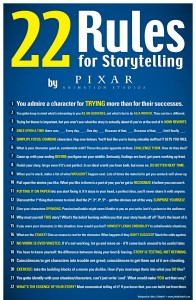
In honor of the National Novel Writing Month (www.nanowrimo.org), in which we are all challenged to write a 50,000 word novel in a month, I wanted to put together a very quick crash course in creative writing. I can tell you having finished my book is the accomplishment I’m most proud of, there’s nothing quite so fulfilling as having done something you didn’t think you could, and overcoming all the obstacles and laziness that try to get in the way. I wish nothing more for you than having this feeling for yourself, so join up! Yes, I know you’re busy, but we’re all busy; we all have 168 hours a week to work with, so jump in; if not now, when?
Although I think the spirit of the challenge is to just get a rough draft done, the number one thing you can do to make the process easier, is the very same thing that will make your book that much better: Having a solid structure. I can’t think of anything that will torpedo your chances of finishing on time faster than just sitting down at the keyboard and writing whatever pops into your head. That is a recipe for hard days when you have no inspiration, and a novel that lags and wanders all over the place.
So the way to counter this is through having your structure and the ‘beats’ (high points) of your story figured out in advance. Once you have decided on the beats, filling in the events in between them because easy. Once you have that, you have your story’s skeleton, so fleshing it out becomes easy.
Well, easier.
The best structure I’ve found was written by Blake Snyder in his book Save the Cat. Although the structure was intended for screenplays, I’ve applied it just as easily to short stories, comic books, and more. You can find a quick overview of it here, although I *highly* recommend you read the whole book. If you want to be a better writer, it really is the place to start.
Now that you have the structure in place, you’ll want to be clear on some of the details you want to include in the story. Pixar’s 22 Rules of Storytelling will give you some quick guidelines for telling a story that people will remember. Again, these rules were primarily aimed a film, but they are just as true about writing fiction:
#1: You admire a character for trying more than for their successes.
#2: You gotta keep in mind what’s interesting to you as an audience, not what’s fun to do as a writer. They can be v. different.
#3: Trying for theme is important, but you won’t see what the story is actually about til you’re at the end of it. Now rewrite.
#4: Once upon a time there was ___. Every day, ___. One day ___. Because of that, ___. Because of that, ___. Until finally ___.
#5: Simplify. Focus. Combine characters. Hop over detours. You’ll feel like you’re losing valuable stuff but it sets you free.
#6: What is your character good at, comfortable with? Throw the polar opposite at them. Challenge them. How do they deal?
#7: Come up with your ending before you figure out your middle. Seriously. Endings are hard, get yours working up front.
#8: Finish your story, let go even if it’s not perfect. In an ideal world you have both, but move on. Do better next time.
#9: When you’re stuck, make a list of what WOULDN’T happen next. Lots of times the material to get you unstuck will show up.
#10: Pull apart the stories you like. What you like in them is a part of you; you’ve got to recognize it before you can use it.
#11: Putting it on paper lets you start fixing it. If it stays in your head, a perfect idea, you’ll never share it with anyone.
#12: Discount the 1st thing that comes to mind. And the 2nd, 3rd, 4th, 5th – get the obvious out of the way. Surprise yourself.
#13: Give your characters opinions. Passive/malleable might seem likable to you as you write, but it’s poison to the audience.
#14: Why must you tell THIS story? What’s the belief burning within you that your story feeds off of? That’s the heart of it.
#15: If you were your character, in this situation, how would you feel? Honesty lends credibility to unbelievable situations.
#16: What are the stakes? Give us reason to root for the character. What happens if they don’t succeed? Stack the odds against.
#17: No work is ever wasted. If it’s not working, let go and move on – it’ll come back around to be useful later.
#18: You have to know yourself: the difference between doing your best & fussing. Story is testing, not refining.
#19: Coincidences to get characters into trouble are great; coincidences to get them out of it are cheating.
#20: Exercise: take the building blocks of a movie you dislike. How d’you rearrange them into what you DO like?
#21: You gotta identify with your situation/characters, can’t just write ‘cool’. What would make YOU act that way?
#22: What’s the essence of your story? Most economical telling of it? If you know that, you can build out from there.
And one last point, from Kurt Vonnegut’s 8 Rules for Writing Fiction:
1. Use the time of a total stranger in such a way that he or she will not feel the time was wasted.
2. Give the reader at least one character he or she can root for.
3. Every character should want something, even if it is only a glass of water.
4. Every sentence must do one of two things — reveal character or advance the action.
*Note, you can also reveal theme, aka what the story is about.
5. Start as close to the end as possible.
6. Be a sadist. Now matter how sweet and innocent your leading characters, make awful things happen to them — in order that the reader may see what they are made of.
7. Write to please just one person. If you open a window and make love to the world, so to speak, your story will get pneumonia.
8. Give your readers as much information as possible as soon as possible. To heck with suspense. Readers should have such complete understanding of what is going on, where and why, that they could finish the story themselves, should cockroaches eat the last few pages.
And there you have it! It’s very possible you can (and hopefully will) spend the rest of your life honing your skills as a story teller, but this is the fastest, firmest foundation I can possibly give to someone just starting out. Now go write something amazing, and remember to thank me in the introduction. I’ll see you at the finish line!
What do you think? Feel free to comment down below!
You are great, and I love you!
And if you love me back, click ‘share’ up at the top!
B. Dave Walters Writer, Life Coach, and Talk Radio Host
Find out more about me: http://about.me/BDaveWalters
Ask me anything: http://formspring.me/BDaveWalters
Become a supporter of my work: http://www.patreon.com/bdavewalters
Pages I support:
Jesus and Buddha — Interfaith dialog
Gnostic Theism — Religion and Spirituality for the 21st Century (Join the Movement!)
Love One Another — A group for the coolest Spiritual people on the Internet!


